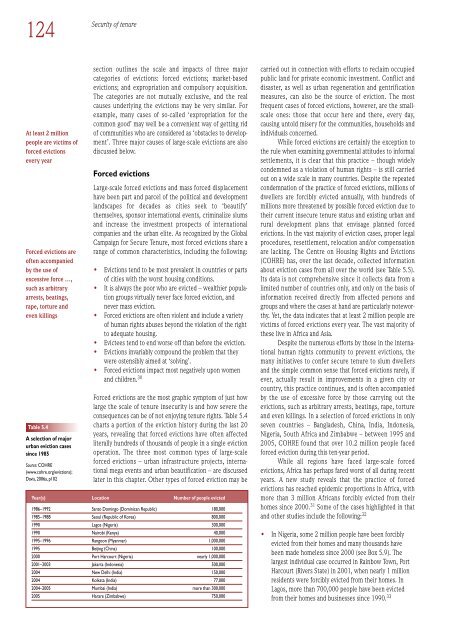Download the file - United Nations Rule of Law
Download the file - United Nations Rule of Law
Download the file - United Nations Rule of Law
- No tags were found...
Create successful ePaper yourself
Turn your PDF publications into a flip-book with our unique Google optimized e-Paper software.
124Security <strong>of</strong> tenureAt least 2 millionpeople are victims <strong>of</strong>forced evictionsevery yearForced evictions are<strong>of</strong>ten accompaniedby <strong>the</strong> use <strong>of</strong>excessive force …,such as arbitraryarrests, beatings,rape, torture andeven killingsTable 5.4A selection <strong>of</strong> majorurban eviction casessince 1985Source: COHRE(www.cohre.org/evictions);Davis, 2006a, p102section outlines <strong>the</strong> scale and impacts <strong>of</strong> three majorcategories <strong>of</strong> evictions: forced evictions; market-basedevictions; and expropriation and compulsory acquisition.The categories are not mutually exclusive, and <strong>the</strong> realcauses underlying <strong>the</strong> evictions may be very similar. Forexample, many cases <strong>of</strong> so-called ‘expropriation for <strong>the</strong>common good’ may well be a convenient way <strong>of</strong> getting rid<strong>of</strong> communities who are considered as ‘obstacles to development’.Three major causes <strong>of</strong> large-scale evictions are alsodiscussed below.Forced evictionsLarge-scale forced evictions and mass forced displacementhave been part and parcel <strong>of</strong> <strong>the</strong> political and developmentlandscapes for decades as cities seek to ‘beautify’<strong>the</strong>mselves, sponsor international events, criminalize slumsand increase <strong>the</strong> investment prospects <strong>of</strong> internationalcompanies and <strong>the</strong> urban elite. As recognized by <strong>the</strong> GlobalCampaign for Secure Tenure, most forced evictions share arange <strong>of</strong> common characteristics, including <strong>the</strong> following:• Evictions tend to be most prevalent in countries or parts<strong>of</strong> cities with <strong>the</strong> worst housing conditions.• It is always <strong>the</strong> poor who are evicted – wealthier populationgroups virtually never face forced eviction, andnever mass eviction.• Forced evictions are <strong>of</strong>ten violent and include a variety<strong>of</strong> human rights abuses beyond <strong>the</strong> violation <strong>of</strong> <strong>the</strong> rightto adequate housing.• Evictees tend to end worse <strong>of</strong>f than before <strong>the</strong> eviction.• Evictions invariably compound <strong>the</strong> problem that <strong>the</strong>ywere ostensibly aimed at ‘solving’.• Forced evictions impact most negatively upon womenand children. 30Forced evictions are <strong>the</strong> most graphic symptom <strong>of</strong> just howlarge <strong>the</strong> scale <strong>of</strong> tenure insecurity is and how severe <strong>the</strong>consequences can be <strong>of</strong> not enjoying tenure rights. Table 5.4charts a portion <strong>of</strong> <strong>the</strong> eviction history during <strong>the</strong> last 20years, revealing that forced evictions have <strong>of</strong>ten affectedliterally hundreds <strong>of</strong> thousands <strong>of</strong> people in a single evictionoperation. The three most common types <strong>of</strong> large-scaleforced evictions – urban infrastructure projects, internationalmega events and urban beautification – are discussedlater in this chapter. O<strong>the</strong>r types <strong>of</strong> forced eviction may beYear(s) Location Number <strong>of</strong> people evicted1986–1992 Santo Domingo (Dominican Republic) 180,0001985–1988 Seoul (Republic <strong>of</strong> Korea) 800,0001990 Lagos (Nigeria) 300,0001990 Nairobi (Kenya) 40,0001995–1996 Rangoon (Myanmar) 1,000,0001995 Beijing (China) 100,0002000 Port Harcourt (Nigeria) nearly 1,000,0002001–2003 Jakarta (Indonesia) 500,0002004 New Delhi (India) 150,0002004 Kolkata (India) 77,0002004–2005 Mumbai (India) more than 300,0002005 Harare (Zimbabwe) 750,000carried out in connection with efforts to reclaim occupiedpublic land for private economic investment. Conflict anddisaster, as well as urban regeneration and gentrificationmeasures, can also be <strong>the</strong> source <strong>of</strong> eviction. The mostfrequent cases <strong>of</strong> forced evictions, however, are <strong>the</strong> smallscaleones: those that occur here and <strong>the</strong>re, every day,causing untold misery for <strong>the</strong> communities, households andindividuals concerned.While forced evictions are certainly <strong>the</strong> exception to<strong>the</strong> rule when examining governmental attitudes to informalsettlements, it is clear that this practice – though widelycondemned as a violation <strong>of</strong> human rights – is still carriedout on a wide scale in many countries. Despite <strong>the</strong> repeatedcondemnation <strong>of</strong> <strong>the</strong> practice <strong>of</strong> forced evictions, millions <strong>of</strong>dwellers are forcibly evicted annually, with hundreds <strong>of</strong>millions more threatened by possible forced eviction due to<strong>the</strong>ir current insecure tenure status and existing urban andrural development plans that envisage planned forcedevictions. In <strong>the</strong> vast majority <strong>of</strong> eviction cases, proper legalprocedures, resettlement, relocation and/or compensationare lacking. The Centre on Housing Rights and Evictions(COHRE) has, over <strong>the</strong> last decade, collected informationabout eviction cases from all over <strong>the</strong> world (see Table 5.5).Its data is not comprehensive since it collects data from alimited number <strong>of</strong> countries only, and only on <strong>the</strong> basis <strong>of</strong>information received directly from affected persons andgroups and where <strong>the</strong> cases at hand are particularly noteworthy.Yet, <strong>the</strong> data indicates that at least 2 million people arevictims <strong>of</strong> forced evictions every year. The vast majority <strong>of</strong><strong>the</strong>se live in Africa and Asia.Despite <strong>the</strong> numerous efforts by those in <strong>the</strong> internationalhuman rights community to prevent evictions, <strong>the</strong>many initiatives to confer secure tenure to slum dwellersand <strong>the</strong> simple common sense that forced evictions rarely, ifever, actually result in improvements in a given city orcountry, this practice continues, and is <strong>of</strong>ten accompaniedby <strong>the</strong> use <strong>of</strong> excessive force by those carrying out <strong>the</strong>evictions, such as arbitrary arrests, beatings, rape, tortureand even killings. In a selection <strong>of</strong> forced evictions in onlyseven countries – Bangladesh, China, India, Indonesia,Nigeria, South Africa and Zimbabwe – between 1995 and2005, COHRE found that over 10.2 million people facedforced eviction during this ten-year period.While all regions have faced large-scale forcedevictions, Africa has perhaps fared worst <strong>of</strong> all during recentyears. A new study reveals that <strong>the</strong> practice <strong>of</strong> forcedevictions has reached epidemic proportions in Africa, withmore than 3 million Africans forcibly evicted from <strong>the</strong>irhomes since 2000. 31 Some <strong>of</strong> <strong>the</strong> cases highlighted in thatand o<strong>the</strong>r studies include <strong>the</strong> following: 32• In Nigeria, some 2 million people have been forciblyevicted from <strong>the</strong>ir homes and many thousands havebeen made homeless since 2000 (see Box 5.9). Thelargest individual case occurred in Rainbow Town, PortHarcourt (Rivers State) in 2001, when nearly 1 millionresidents were forcibly evicted from <strong>the</strong>ir homes. InLagos, more than 700,000 people have been evictedfrom <strong>the</strong>ir homes and businesses since 1990. 33
















